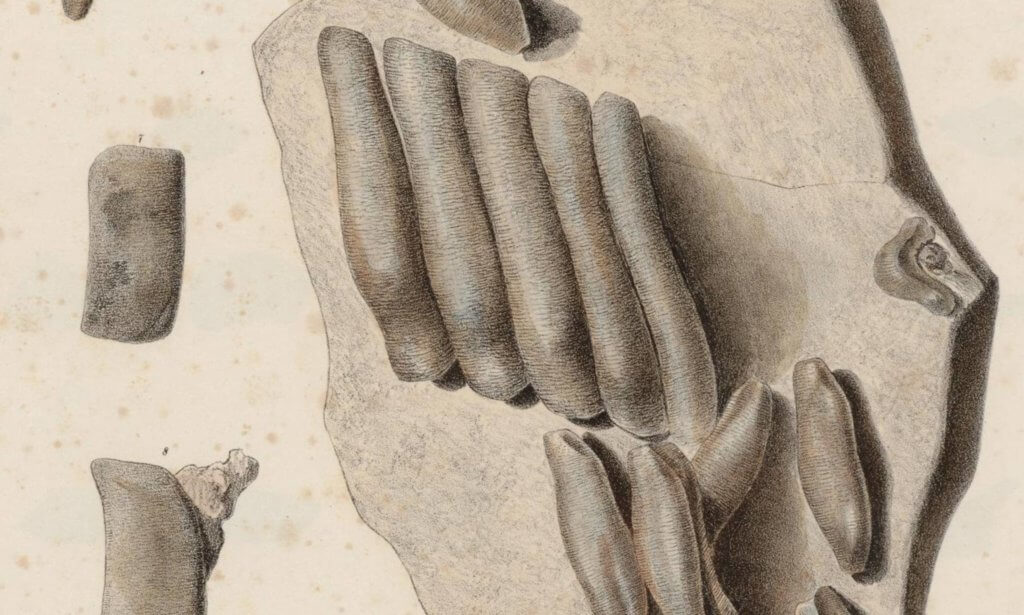Catalog Number: CG-0101
Until yesterday, I was very singular in my knowledge of Pennsylvanian fossil shark teeth. Petalodus is the only genus of tooth I have found that I was aware of. I pulled an exciting piece from the rocks yesterday. This slab has a similar coloring to the Petalodus teeth I’ve seen. However, one difference is the pitted appearance it has.
I occasionally rely on dedicated people who spend time on the Fossil Forum. In this age dominated by Facebook and Instagram, this older-style message board is quite an active community full of knowledgeable people. If I find something obscure, I post it there. Sometimes I don’t get a reply; others identify things quickly. Last night they were quick.

Holocephalian Tooth Plate Subclass and Likely Genus
This piece is known as a Holocephalian Tooth Plate. The subclass Holocephali belongs to the same class as Petalodus, Chondrichthyes. Holocephali still exists, having been in the fossil record for the past 416 million years. While much research and cataloging have been done on these, my current knowledge is still low. I believe these pieces are often hard to identify, being somewhat the same when found as fragments.
Determining a Genus
The genus is Psammodus, probably. I still have much research to do about the genus as a whole. Fossilworks lists eighteen species of Psammodus; judging by Petalodus, several may be synonymous with each other. Many of the species’ names appear designated based on their physical appearance.

These pavement-type teeth specialize in crushing mollusks and other creatures with a shell to protect them. Trilobites are likely another meal for a fish with teeth. The classic shark tooth shape is for latching onto and shredding prey. However, it’s not unheard of for these to attack mollusks, just not as expected.
Louis Agassiz’s Psammodus
The following screens are from Louis Agassiz’s Recherches sur les poissons fossiles. The five-volume work is chock full of excellent illustrations of many fossil fish. He published these over ten years, from 1833 to 1843. He wrote the book in his native French language. You can read the book visually using Google translate through your phone camera. Another option is to paste the OCR text from the book.
The teeth illustrations in table 13 are very similar to my specimen. However, the teeth in table 15 seem to be from something different.


Local Psammodus Specimens
I have yet to find any evidence of anyone finding these in Pennsylvania or Ohio. One of my go-to books, Fossils of Ohio, contains no information about Psammodus. The fossils that helped identification first are from the La Salle Limestone in Illinois, which closely correlates with the Brush Creek Limestone (Harper 2020, personal communication).
A second consideration: Deltodus
Deltodus is currently a possibility. It also has been at least reported locally in a 1917 Carnegie Museum publication. However, these teeth are not relatively as flat, and this specimen has a bit of a wave to its shape.
Holocephalian Tooth Plate Microscope Photos








References for Psammodus, Deltodus, and other Holocephalian Teeth
- 1833-43, Agassiz, Louis, Recherches sur les poissons fossiles, v. 3 atlas, Plate 13.
- 1833-43, Agassiz, Louis, Recherches sur les poissons fossiles, v. 3 atlas, Plate 16.
- Wikipedia, Holocephali – Online Article
- Fossil Works – Genus Listing Page for Psammodus
- 1971, Moy-Thomas J.A., Subclass Chondrichthyes. Infraclass Holocephali. In: Palaeozoic Fishes. Springer, Boston, MA
- 2004, Ginter, M. and Piechota, A., The first Devonian holocephalian tooth from Poland, Acta Palaeontologica Polonica, 49 (3): 409–41
- 2013, Carnall, M., Underwhelming Fossil Fish of the Month: July, University College London
- 2013, Psammodus sp. 1, Paleontological internet portal Ammonit.ru
- 2018, psammodus rather big, Paleontological internet portal Ammonit.ru

